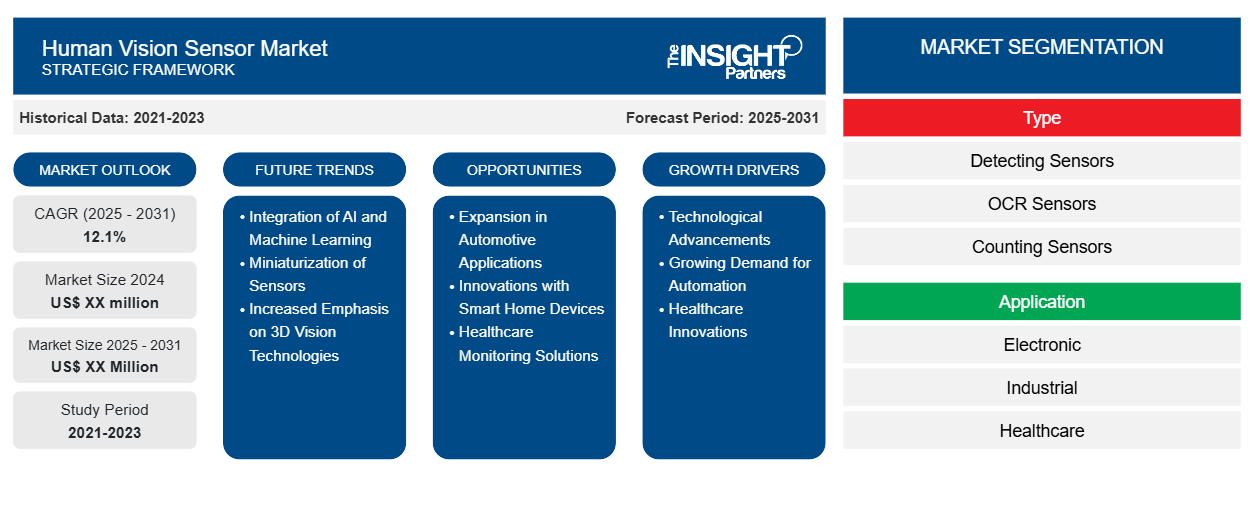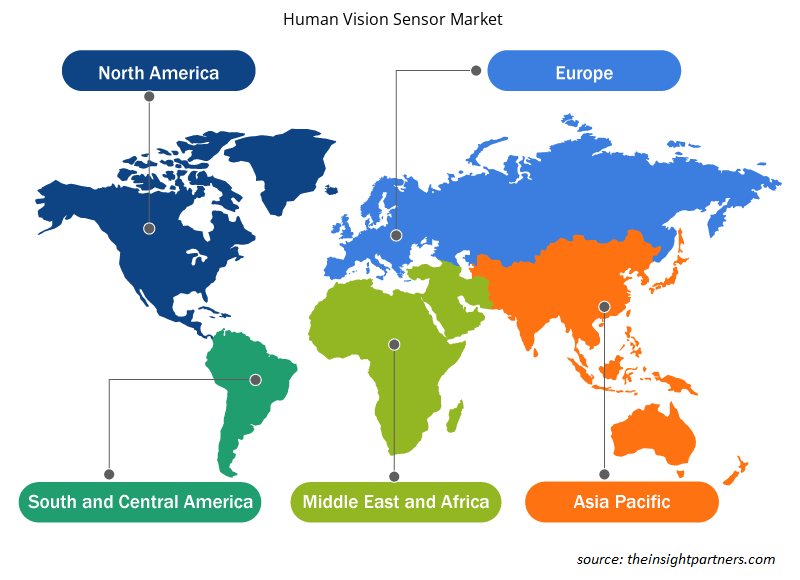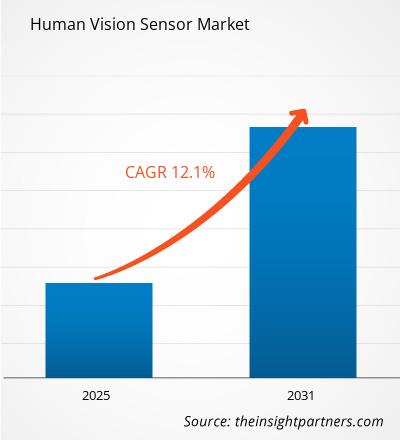预计 2025 年至 2031 年期间人类视觉传感器市场复合年增长率为 12.1%,市场规模将从 2024 年的 XX 百万美元扩大到 2031 年的 XX 百万美元。
报告按类型(检测传感器、OCR 传感器、计数传感器、测量传感器、其他);应用(电子、工业、医疗保健、航空航天)细分。全球分析进一步细分为区域和主要国家。报告以美元为单位提供上述分析和细分的价值。
报告目的
Insight Partners 发布的《人类视觉传感器市场》报告旨在描述当前形势和未来增长、主要驱动因素、挑战和机遇。这将为各种业务利益相关者提供见解,例如:
- 技术提供商/制造商:了解不断变化的市场动态并了解潜在的增长机会,从而能够做出明智的战略决策。
- 投资者:对市场增长率、市场财务预测以及整个价值链中存在的机会进行全面的趋势分析。
- 监管机构:监管市场政策和警察活动,旨在最大限度地减少滥用行为,维护投资者的信任和信心,维护市场的完整性和稳定性。
人类视觉传感器市场细分
类型
- 检测传感器
- OCR 传感器
- 计数传感器
- 测量传感器
- 其他
应用
- 电子的
- 工业的
- 卫生保健
- 航天
定制此报告以满足您的需求
您可以免费定制任何报告,包括本报告的部分内容、国家级分析、Excel 数据包,以及为初创企业和大学提供优惠和折扣
人类视觉传感器市场:战略洞察

- 获取此报告的关键市场趋势。这个免费样品将包括数据分析,从市场趋势到估计和预测。
人类视觉传感器市场增长动力
- 技术进步:传感器技术的快速发展,尤其是人工智能和机器学习,正在推动人类视觉传感器市场的发展。增强的图像处理能力可以提高检测物体的准确性和速度,这对于自动驾驶汽车、安全系统和机器人等应用至关重要。这些进步使视觉系统更加复杂和可靠,从而增加了市场需求。
- 自动化需求不断增长:随着各行各业越来越多地采用自动化来提高效率和降低运营成本,对先进人体视觉传感器的需求也随之增加。这些传感器促进了机器视觉在制造、物流和质量控制过程中的应用。通过实现实时监控和决策,人体视觉传感器正成为自动化系统中必不可少的组成部分,进一步推动市场增长。
- 医疗保健创新:医疗保健行业越来越多地利用人类视觉传感器进行诊断和监测。光学相干断层扫描和先进成像系统等技术通过提供详细的视觉数据来及早发现疾病,从而改善患者的治疗效果。随着医疗保健行业不断创新,对精确可靠的视觉传感器的需求预计将增长,从而对市场产生重大影响。
人类视觉传感器市场未来趋势
- 人工智能与机器学习的集成:人类视觉传感器是人工智能与机器学习算法集成的最流行趋势。这将使视觉传感器能够实时解释/分析视觉数据,从而为自动驾驶汽车、监控系统等应用提供更好的智能决策方法,并提高效率和准确性。
- 传感器小型化:另一个趋势是人体视觉传感器的小型化。这符合对紧凑、轻便和坚固产品的要求。小型化将使传感器完全隐形,并无缝集成到各种消费电子产品中,例如智能手机和可穿戴设备。这将允许在增强现实和个人健康监测方面实现全新的应用,从而进一步扩大市场的覆盖面和多功能性。
- 更加重视 3D 视觉技术:随着对 3D 视觉技术的日益重视,人类视觉传感器市场发现自己在市场上占据了上风。该技术提供深度感知和空间意识,该功能的应用可以在开发机器人、自动化和虚拟现实中看到。这种通过捕获和分析 3D 数据来洞察事物的能力增加了用户体验并使操作更加高效。这就是为什么 3D 视觉成为市场上的主要趋势领导者的原因。
人类视觉传感器的市场机会
- 汽车应用领域的扩展:鉴于自动驾驶和半自动驾驶汽车开发水平的快速提升,该市场拥有真正的力量源泉。这些传感器是 ADAS 高级驾驶辅助系统的关键,旨在使车辆安全和导航更接近完美。随着汽车制造商对这些发展的兴趣日益浓厚,随着先进视觉传感器的使用获得更大的推动力,未来几年市场必将进一步扩大。
- 智能家居设备的创新:智能家居技术是一种新兴趋势,为人类视觉传感器市场提供了广阔的空间。安全摄像头、智能门铃和自动照明系统中的面部识别和运动检测等高级功能需要前瞻性的功能。随着视觉传感器与智能家居设备的集成,消费者或用户追求的任何此类高级安全性和便利性都将激发巨大的市场机会。
- 医疗监测解决方案:远程医疗监测和远程医疗服务在医疗服务提供商中的需求不断增长,而人体视觉传感器是其中的一个独特机会。它们可以实现无创监测患者;然后,医疗专业人员可以通过分析视觉数据来评估病情。随着医疗行业越来越多地采用技术来护理患者,由于市场增长的预期趋势,诊断工具将与视觉传感器相结合。
人类视觉传感器市场区域洞察
Insight Partners 的分析师已详尽解释了预测期内影响人类视觉传感器市场的区域趋势和因素。本节还讨论了北美、欧洲、亚太地区、中东和非洲以及南美和中美洲的人类视觉传感器市场细分和地理位置。

- 获取人类视觉传感器市场的区域特定数据
人类视觉传感器市场报告范围
| 报告属性 | 细节 |
|---|---|
| 2024 年的市场规模 | XX 百万美元 |
| 2031 年市场规模 | XX 百万美元 |
| 全球复合年增长率(2025 - 2031) | 12.1% |
| 史料 | 2021-2023 |
| 预测期 | 2025-2031 |
| 涵盖的领域 | 按类型
|
| 覆盖地区和国家 | 北美
|
| 市场领导者和主要公司简介 |
|
人类视觉传感器市场参与者密度:了解其对业务动态的影响
人类视觉传感器市场正在快速增长,这得益于终端用户需求的不断增长,而这些需求又源于消费者偏好的不断变化、技术进步以及对产品优势的认识不断提高等因素。随着需求的增加,企业正在扩大其产品范围,进行创新以满足消费者的需求,并利用新兴趋势,从而进一步推动市场增长。
市场参与者密度是指在特定市场或行业内运营的企业或公司的分布情况。它表明在给定市场空间中,相对于其规模或总市场价值,有多少竞争对手(市场参与者)存在。
在人类视觉传感器市场运营的主要公司有:
- iniLabs 有限公司
- 欧姆龙公司
- 東京光電股份有限公司
- 基恩士公司。
- 威格勒传感器有限公司
免责声明:上面列出的公司没有按照任何特定顺序排列。

- 了解人类视觉传感器市场主要参与者概况
主要卖点
- 全面覆盖:报告全面涵盖了人类视觉传感器市场的产品、服务、类型和最终用户的分析,提供了整体概况。
- 专家分析:报告基于对行业专家和分析师的深入了解而编写。
- 最新信息:该报告涵盖了最新信息和数据趋势,确保了其与业务的相关性。
- 定制选项:此报告可以定制以满足特定客户要求并恰当地适应业务策略。
因此,人类视觉传感器市场研究报告有助于引领解码和了解行业情景和增长前景。尽管可能存在一些合理的担忧,但本报告的总体优势往往大于劣势。
- 历史分析(2 年)、基准年、预测(7 年)及复合年增长率
- PEST和SWOT分析
- 市场规模、价值/数量 - 全球、区域、国家
- 行业和竞争格局
- Excel 数据集
近期报告
相关报告
客户评价
购买理由
- 明智的决策
- 了解市场动态
- 竞争分析
- 客户洞察
- 市场预测
- 风险规避
- 战略规划
- 投资论证
- 识别新兴市场
- 优化营销策略
- 提升运营效率
- 顺应监管趋势




















 获取免费样品 - 人类视觉传感器市场
获取免费样品 - 人类视觉传感器市场